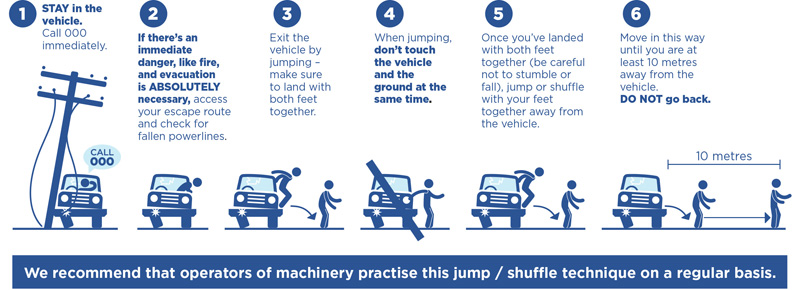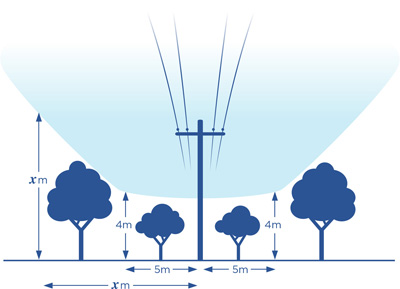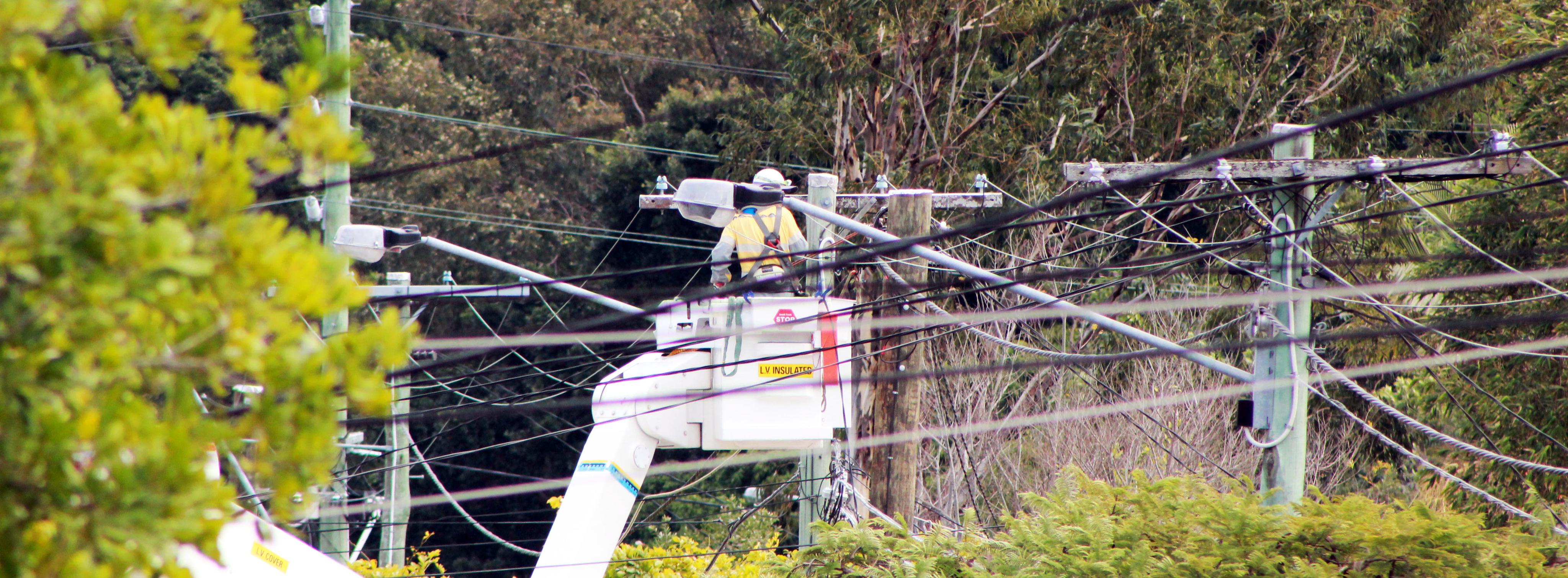Safety advice
If you can’t avoid working in the exclusion zone of an overhead powerline, you’ll need to get written safety advice from us before you start.
Complete our Safety Advice Request Form to obtain written safety advice from us.
Once we receive your request, the relevant field crew will get in touch to arrange a time to meet on site. Make sure you bring the following paperwork as we’ll refer to these at the meeting:
- a copy of the Electrical Safety Code of Practice 2020 - Working near overhead and underground electric lines
- a Before You Dig Australia plan with the location of underground assets (if applicable)
- Authorised Persons documentation (if applicable).
Please note: If you don’t comply with safety advice or electrical safety laws, your details could be forwarded to the Electrical Safety Office.
Look up and Live map
Our Look up and Live map gives you:
- an interactive map for locating powerlines
- powerline safety guidelines, including powerline exclusion zones
- options for planning or performing work e.g. powerline visual indicators
- Information on de-energisation or relocation of powerlines
- safety advice and high load forms
- Dial Before You Dig enquiry.
You can also download the map as the Look up and Live app.
 |  |
|---|
Fire near powerlines
Fires burning near powerlines can endanger people, animals and objects, and can interrupt electricity supply.
If you see a fire that poses a risk to property or lives, call Triple zero (000) immediately.
When to notify us
Call us if:
- you know of a fire underneath or near a powerline, even if you’re not sure if it poses a risk
- you’re planning fire activity near powerlines. We can give you safety advice and be ready to respond if the fire causes a fault in the network.
Safety tips
To stay safe when fire’s close to a powerline:
- make sure people, vehicles and attachments are at least 25 metres from the powerline
- remember that high voltage electricity can ‘jump’ across several metres of air gap. This means you don’t have to be in direct contact with a high voltage powerline to get a potentially fatal electric shock
- be aware that smoke can act as a conductor. Fires burning on or near powerline easements can increase the chances of a flashover
- don’t count on rubber tyres on vehicles to stop a flashover
- note that powerlines can sag in times of high demand, high temperature and fires, reducing the ground clearance
- don’t stockpile, windrow or heap combustible material under high voltage powerlines
- be careful if you’re using a powerline easement as a firebreak, or a break for starting back-burning operations, or as a refuge area in a firestorm.
For more information, download our Fire and high voltage powerline safety flyer (PDF 1.4 mb).
What to do in a vehicle accident
An accident can bring down powerlines or damage other electrical equipment. If you’re involved in an accident or witness one, 'Take care, stay line aware'. Remember that a car, and anything else in contact with powerlines can be 'live'.
Safety tips
- Treat all powerlines and other electrical equipment as if they’re 'live'
- Stay in the car until the power has been isolated and the powerlines removed. If you leave the car before the power is disconnected, you risk being electrocuted
- Warn bystanders to stay at least 10 metres from the car and anything else in contact with powerlines
- Don't approach a car that’s in contact with powerlines, or allow anyone else to
- Call Triple zero (000) immediately to report powerlines down and a life-threatening situation
- Call us on 13 19 62 to switch off the power

Trees near powerlines
Trees planted near powerlines can contact the lines and interrupt power supply during storms and high winds. Before you plant near powerlines, think about how high and wide your tree will grow. Choose a low-growing species. You can check our Plant Smart search for powerline friendly plants in your council area.
IMPORTANT: Never trim trees or other vegetation near powerlines yourself. Call a professional tree trimmer.
If trees are close to or brushing a service line which connects power to a home, this shouldn’t cause a problem.
Refer to our Trees and powerlines flyer (PDF 1.8 mb) for more information.
Unsuitable trees
Some trees just aren't suited to growing near powerlines, especially if they grow fast and tall or drop large branches in high winds. Some examples include:
- Bamboo species
- Tall palms
- Climbing vines
- Tall Eucalyptus species
- Camphor Laurel (Cinnamomum camphora)
- Pepperina/Peppercorn tree (Schinus molle var. areira.).
Examples of trees that don’t cope with high winds include:
- Yellow flame tree (Peltophorum pterocarpum)
- African mahogany (Khaya senegalensis)
- River blue gum (Eucalyptus tereticornis)
- Weeping fig (Ficus benjamina)
- Pink trumpet tree (Tabebuia impetiginosa).
If a plant on private property poses a risk to electrical safety or power supply, our contractors will negotiate with the landholder to remove it.
Before you plant
- Visit Before You Dig Australia to find out if there are underground cables on or near your property
- Consider how plants and trees will impact visibility from your driveway, intersection sight lines and access to your property
- Consider pedestrian traffic, mail service and garbage truck access
- Check required clearance from streetlights
- Check with your council for planting guidelines, especially if you plan to plant on a council footway. If you want to plant trees on council-controlled land other than streets or council footways, you may need written permission
- Check our Plant Smart search for powerline friendly plants in your council region.
Where to plant
- Plant trees at least 3 metres away from power poles
- If your tree grows to 5 metres tall, you should plant it 5 metres away from the power pole. If it grows to 10 metres, it should be 10 metres away
- Plant shrubs or small trees one metre inside the kerb where the council footway is a minimum of four metres wide
- Allow for at least a 2 metre gap between the service wire to your home and the height of mature trees.
The diagram below shows the recommended minimum distance between a pole and a grown tree, and the desired maximum grown height of trees under powerlines.

Tips for thriving plants
- Dig a hole 300mm from the edge of the root ball on the tree
- Loosen up the sides of the hole to promote root penetration
- Use water crystals to help with water retention
- Create a well around your tree with soil to help retain water and reduce water runoff
- Place mulch to a depth of 150mm around the base of your tree, but away from the trunk to prevent rot
- Thoroughly water a tree straight after planting. Water regularly in dry weather (check under the mulch to see if the soil is dry). Even drought-tolerant plants need to be watered regularly until their roots become established
- Native trees can be fertilised for better growth. Use a fertiliser that’s low in phosphorus, marked as ‘P’ on the label of the bag. Check your fertiliser is suitable, by checking the N:P:K (nitrogen - phosphorus - potassium) composition. Use one that contains less than 3% P. Those with low P but high N and K are fine, e.g. 11:2:13.
Awareness sessions
We offer awareness sessions on how to work safely near overhead and underground powerlines. Our team of highly experienced presenters can deliver sessions at conferences or to business groups, local councils or emergency services groups. We explain how to comply with electrical safety laws and meet the requirements of Ergon Energy and Energex. We cover topics such as exclusion zones, safety observer zones and how to safely operate plant and vehicles near powerlines.
To find out more about awareness sessions or to book a session, simply send us an email and we’ll get back in touch.
Want more information?
FAQs
If you have more questions, you might find answers in our Frequently Asked Questions.
Safety fact sheets
Download our fact sheets for information about working safely near powerlines, including some specific guidelines for different industries.
- Agriculture industry (PDF 1.6 mb)
- Building and construction industry (PDF 1.6 mb)
- Buildings, structures and billboards (PDF 1.4 mb)
- Cotton industry (PDF 1.6 mb)
- Fire and high voltage powerline safety (PDF 1.4 mb)
- Look up and Live - Exclusion zones (PDF 624.9 kb)
- Low-level flying (PDF 1.4 mb)
- Marking overhead powerlines and electrical assets (PDF 1.8 mb)
- Plumbing industry (PDF 1.3 mb)
- Sugar cane farms (PDF 2.0 mb)
- Trees and powerlines (PDF 1.8 mb)

